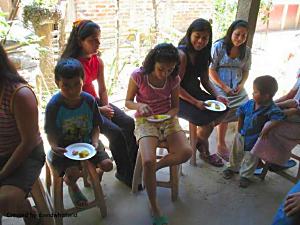
Solar Cooking Spreads to Central America
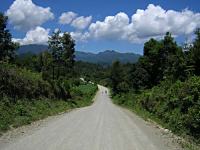 Undulating mountain ranges dotted with extinct volcanoes, lush, fertile, flat lowlands, and brilliant, blue Pacific waters that lap sparkling, white beaches all epitomize the beauty of Central America. However, underneath the beauty, Central America and its people are caught in a social and environmental emergency.
Undulating mountain ranges dotted with extinct volcanoes, lush, fertile, flat lowlands, and brilliant, blue Pacific waters that lap sparkling, white beaches all epitomize the beauty of Central America. However, underneath the beauty, Central America and its people are caught in a social and environmental emergency.
With approximately 6.5 million people living in El Salvador, it is the most densely populated country in the Americas. Although not as populated, Guatemala has 14.5 million living within its boundaries. At present, in both El Salvador and Guatemala, the fertility rate is between 3.58-4.4 children per woman with a concurrent average growth rate of 2-2.6% percent per annum. Through their agricultural land uses and subsistence activities, the large populace places extreme pressure on the natural resources.
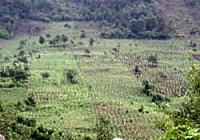 El Salvador has suffered a 92 percent loss of forest cover and currently experiences a deforestation rate of 4.1 percent. In Guatemala, forest cover loss is around 66% with a 2% annual deforestation rate. Approximately 65% of the population uses wood to cook, but the practice contributes significantly to ongoing deforestation. At present, El Salvador and Guatemala have some of the most threatened ecosystems on the planet.
El Salvador has suffered a 92 percent loss of forest cover and currently experiences a deforestation rate of 4.1 percent. In Guatemala, forest cover loss is around 66% with a 2% annual deforestation rate. Approximately 65% of the population uses wood to cook, but the practice contributes significantly to ongoing deforestation. At present, El Salvador and Guatemala have some of the most threatened ecosystems on the planet.
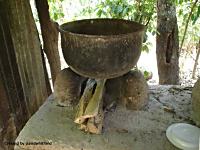 Cooking with wood not only places extreme stresses the environment, but also women and children. In Central America, women typically cook inside small, closed rooms. At times, there is not even a window in the kitchen. As a result, women, girls, and young children spend hours every day inhaling toxic cooking smoke.
Cooking with wood not only places extreme stresses the environment, but also women and children. In Central America, women typically cook inside small, closed rooms. At times, there is not even a window in the kitchen. As a result, women, girls, and young children spend hours every day inhaling toxic cooking smoke.
Since domestic responsibilities fall on women and girls, they have the job of procuring firewood. Due to the high deforestation, they are forced to forage long hours and travel far from their homes in search of wood. Presently, they spend about 3-4 hours 3-5 times a week searching for fuel with which to cook. Searching for wood represents lost opportunities for both the women and girls. In the time spent foraging, women miss opportunities to participate in income generating activities and young girls forego attending school.
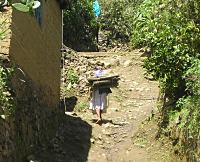 Finally, in many places, wood no longer exists to collect. In these areas, families must pay for firewood and/or gas. Although the average rural family earns only about $120 a month, cooking gas costs around $5 per month and firewood around $20 per month. Families can spend up to 25% of their monthly income on cooking fuel.
Finally, in many places, wood no longer exists to collect. In these areas, families must pay for firewood and/or gas. Although the average rural family earns only about $120 a month, cooking gas costs around $5 per month and firewood around $20 per month. Families can spend up to 25% of their monthly income on cooking fuel.
In April 2005, I traveled to El Salvador and Guatemala to conduct solar cooking demonstrations in rural villages. After driving 4 hours on dusty, bumpy roads through the countryside, we arrived in small, scattered villages. Upon arrival, we filled three different HotPots with chicken, corn, and plantains. As our invited guests, local village women, NGO representatives, governmental officials, private solar lighting company owners, and Peace Corps volunteers, arrived at the demonstration sites, they saw a strange sight. All were curious about the HotPot and spent several minutes examining and touching it. Most of the women told me that they had not known that the sun could be used for cooking.
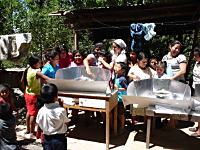 While the food was cooking in the sun, we relaxed in the shade and spoke about solar cooking. We talked about the design of the HotPot, how it works, and the need for it. After 2.5 hours, all the food was cooked and everyone was able to try a portion. After tasting the food, all of the women were convinced of its ability to cook. They said that the food tasted excellent and were amazed at how easy it was to use. In one village, the women asked if they could buy the HotPots that we were using for the demonstration!
While the food was cooking in the sun, we relaxed in the shade and spoke about solar cooking. We talked about the design of the HotPot, how it works, and the need for it. After 2.5 hours, all the food was cooked and everyone was able to try a portion. After tasting the food, all of the women were convinced of its ability to cook. They said that the food tasted excellent and were amazed at how easy it was to use. In one village, the women asked if they could buy the HotPots that we were using for the demonstration!
Currently, Solar Household Energy, Inc is working with several NGOs and private entrepreneurs to bring HotPots to the people of El Salvador and Guatemala.
